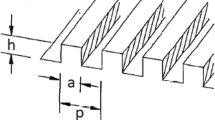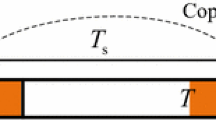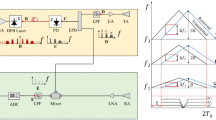Abstract
In radar systems with a common Tx/Rx antenna, duplexers are used to separate Tx/Rx signals during operation. Especially for high-power radar systems, Tx/Rx duplexers are key components, affecting the overall system performance. This letter presents a novel Tx/Rx duplexer concept, suitable for circular full-polarimetric radar operation with multi-kW transmission power and broad bandwidth. The concept allows to push the reconnaissance capability of future broadband high-power radar sensors for space observation.
Similar content being viewed by others
Avoid common mistakes on your manuscript.
1 Introduction
In order to cope with the new conditions of ever more and ever smaller satellites in orbit, an improvement in the reconnaissance capability of future high-power radar sensors for space observation is required. This may be achieved with broadband sensors, suitable for full-polarimetric as well as interferometric radar operation. While interferometric radar operation demands special requirements on the coherence and synchronization of multiple radar transmitters/receivers, full-polarimetric radar operation demands new concepts for high-power radar frontends.
State-of-the-art quasi-optical duplexer concepts are discussed in detail in [1,2,3]. The key improvement of the duplexer concept discussed in this letter is the capability of electronically polarization switching, pulse-to-pulse, and with a high pulse repetition frequency (PRF), while combining the output power of all operational amplifier chains. To the best knowledge of the author, a similar duplexer concept as discussed in this letter has not yet been published elsewhere.
The letter is organized as follows: In Section 2, the principle concept of operation is discussed, while in Section 3 a corresponding mathematical formalism is given. This is used in Section 4 for a X-Pol tolerance analysis. Section 5 closes with a conclusion.
2 Principle Concept of Operation
Figure 1 shows a simplified block diagram of the duplexer concept presented. Key component is a coherent multi-channel arbitrary waveform generator (AWG). The AWG is able to switch between in-phase (\(\Delta \varphi =0^\circ\)) and out-of-phase condition (\(\Delta \varphi =180^\circ\)) in respect to its identical output signals. Hereto, the multiplication factor within the AWG H-Channel (see Fig. 1) is toggled by \(\pm 1\).
The AWG output signals are up-converted, amplified, and launched into a quasi-optical radar frontend. Note that one of the signals is launched as a horizontally polarized wave (H-Channel) while the other one is launched as a vertically polarized wave (V-Channel).
The wire grids at point 1a/1b (see Fig. 1) are oriented such that both waves are able to transmit during transmission. Then, the polarization axes of both waves are rotated by 45° using corresponding Faraday rotators (Fig. 1: rotator A/B). The principle concept of a Faraday rotator is discussed in detail in [1, 4,5,6,7,8].
The wire grid at point 2 is oriented such that the wave coming from point 1b is able to transmit during transmission, while the wave coming from point 1a is reflected. Depending on the sign considered within the AWG H-Channel, both waves overlap to form a vertically/horizontally polarized wave at point 2. This is illustrated as vector diagrams in Fig. 2.
Principle vector diagram Tx. Orange: V-Channel; blue: H-Channel (\(\pm\) 1). 1a/b … 4: position name (see Fig. 1)
After superposition, the vertically/horizontally polarized wave passes rotator C which leads to an + 67.5°/ − 22.5° linear polarized output wave at point 3 (see Fig. 2). This wave then is transposed to a left-hand-rotated (LHR)/right-hand-rotated (RHR) polarized wave at point 4 using a “Venetian-blind” type polarizer. The polarizer is aligned by + 22.5°. The principle concept of a “Venetian-blind” type polarizer is discussed in detail in [1, 9].
Note that switching the linear polarization axes at point 3 by 90° acts identically to rotating the polariser axially by 90°, switching the circular output polarization. However, mechanically moving components will not support fast polarization switching, pulse-to-pulse, and with a high PRF. In the duplexer concept presented, circular polarization switching is released by toggling the multiplication factor within the AWG H-Channel (\(\pm 1\); see Fig. 1). This allows fast polarization switching pulse-to-pulse and with a high PRF. No mechanically moving components are required. Furthermore, the RF signals of both amplifier chains are power-combined, doubling the RF output power.
Another way to understand the principle concept of polarization switching in transmission is to look after the phase relation at the polarizer output. As discussed in more detail in [1, 9], within a “Venetian-blind” type polarizer, the linear polarized input wave splits up into a TEM mode and a TE1 mode, propagating through the polarizer. Due to the different phase velocities of both modes, a phase shift of 90° is able to set up. This leads to a circular polarized output wave [10]. Within the duplexer concept presented, the AWG H-Channel provides the wave component, propagating as TEM mode. The AWG V-Channel provides the wave component, propagating as TE1 mode. By toggling the multiplication factor within the AWG H-Channel, the phase relation at the polarizer output is able to switch between \(\pm\) 90°: With the multiplication factor (+ 1), both wave components are in-phase (\(\Delta \varphi = 0^\circ\)) at the polarizer input. The polarizer causes a − 90° phase shift, relative to both wave components, leading to an RHR output wave. With the multiplication factor (− 1), both wave components are out-of-phase (\(\Delta \varphi^\circ =180^\circ )\) at the polarizer input. The polarizer causes an additional − 90° phase shift, leading to an − 270° = + 90° phase shift at the polarizer output, corresponding to an LHR output wave.
During reception, the incoming LHR/RHR wave components at point 4 are transposed to an + 67.5°/ − 22.5° linear polarized wave at point 3, by the reciprocal “Venetian-blind” type polarizer. Both wave components then pass the common rotator C which leads to + 45°/ − 45° polarized wave components at point 2. There, the wave components are separated by the wire grid C: The + 45° polarized wave component transmits and propagates in direction of point 1b. The − 45° polarized wave component reflects and propagates in the direction of point 1a. Before reception by the receiver frontends, both waves pass an additional rotator (Fig. 1: rotator A/B) which aligns the corresponding waves to reflect onto the wire grid surfaces at position 1a/1b (Fig. 1: wire grid A/B). The process of polarization rotation during reception is illustrated as vector diagrams in Fig. 3. Note that the vector diagrams in Figs. 2 and 3 are drawn in a common coordinate system.
Principle vector diagram Rx. Green: RHR reception; yellow: LHR reception. 1a/b … 4: position name (see Fig. 1)
For simplicity, metal mirrors required for beam refocusing are not shown in Fig. 1. These create corresponding beam waists at the single rotators and the polarizer position.
In [2], a non-polarimetric high-power Ka-Band radar sensor for space observation with 60 kW peak transmission power, 12 kW average transmission power, and up to 5 GHz (\(\widehat{=}\approx\) 14%) operational bandwidth is presented. Design considerations on broadband matched Faraday rotators and X-Pol compensated mirror arrangements for advanced multimode monopulse operation as well as a broadband matched and frequency compensated polarizer were carried out. These let expect that the performance parameters given in [2] are able to transfer to full-polarimetric radar operation, based on the duplexer concept presented. Note that in [2] already two high-power amplifier chains are used.
In [11], a non-polarimetric high-power W-Band radar sensor for space observation with nominal 500 W peak transmission power, 200 W average transmission power, and 8 GHz (\(\widehat{=}\approx\) 8%) operational bandwidth is presented. Again, design considerations on corresponding quasi-optical microwave components were carried out. These let expect that the performance parameters given in [11] are able to transfer to full-polarimetric radar operation, based on the duplexer concept presented. Note that a second high-power amplifier would be required, which, however, would also double the RF output power.
The design considerations on corresponding quasi-optical microwave components are out-of-scope of the present letter and will be discussed in more details in an upcoming manuscript.
3 Jones Formalism
To express the principle concept of operation in a mathematical form, the Jones formalism [12, 13] is used. Thereby, a polarized wave is represented as a vector, determined by those electrical field components. System components are expressed as corresponding 2 \(\times\) 2 matrices.
-
A. Components
-
1) Rotator
-
The rotator may be expressed as rotation matrix:
-
2) Wire Grid
For \(\theta =0\), the wire grid shall be aligned in vertical direction. For a tilted wire grid in transmission, this leads to [12]:
For a tilted wire grid in reflection follows:
with \(\mathbf{I}\) as the 2 \(\times\) 2 identity matrix.
-
3) Polarizer
The polarizer is expressed as tilted, variable phase offset regarding the vertical polarized wave component:
-
B. Tx-Mode
In transmission, the input waves may be expressed as:
with \(\Delta A\)/\(\Delta \varphi\) as the amplitude/phase in-balance (in ideally: \(\Delta A\) = 1, \(\Delta \varphi\) = 0).
The transmitted wave follows as:
In ideal conditions, the output wave is perfectly circularly polarized. Taking into account non-ideal behavior, an X-Pol component will set up. To separate the Co-Pol / X-Pol components, the squared magnitude of the scalar-product of the output wave and the considered output wave is calculated:
The X-Pol component follows as:
-
C. Rx-Mode
In reception, the input waves may be expressed as:
The wave components at the receiver frontends follow as:
Again, to separate the Co-Pol/X-Pol components, the squared magnitude of the scalar-product of the output wave and the considered output wave is calculated:
The X-Pol component follows as:
4 X-Pol Tolerance Analysis
The introduced mathematical formalism is used for a tolerance analysis regarding X-Pol performance.
The overall X-Pol performance shall be in the order of − 30 dB. The error terms on component level have to be somewhat smaller than these − 30 dB, hereby.
-
A. Channel In-Balance
An amplitude/phase in-balance may impair the wave superposition in transmission and will set up an X-Pol component. The term refers to point 2, here (see Fig. 1). Figure 4 shows the results of the channel in-balance analysis.
Based on Fig. 4, the design goal regarding channel in-balance is: \(\mathrm{\Delta \Phi }< \pm 2^\circ\), \(\Delta A<\pm 0.15 \mathrm{dB}\). This may be ensured due to a proper linear calibration filter in one of the AWG channels.
-
B. Polarizer Phase Error
Ideally, the polarizer will introduce a 90° phase shift, independent of frequency. In practice, a dispersion effect will occur. Figure 5 (blue line) shows results of the polarizer phase error analysis.
Based on Fig. 5, the design goal regarding the polarizer phase error is \(\Delta \psi < \pm 3^\circ\) within the frequency range of operation.
-
C. Alignment
The following alignment analysis refers to the polarizer and the wire grid C in reception. Note that a rotation error of the rotator C acts identically.
Misalignment of the input wire grids A/B will lead to an amplitude in-balance in transmission and therefore already are considered within the channel in-balance analysis. In reception, misalignment will lead to a signal attenuation and will not cause an X-Pol component, here. This also applies to the 45° rotators A/B.
Figure 5 (brown line) shows results of the alignment analysis. It follows: \(\Delta \chi < \pm\) 1.5°
To derive requirements on the wire grids A/B and the rotators A/B, the acceptable power loss in transmission, caused due to reflection, may be considered. Figure 6 shows corresponding results. The accepted power loss shall be − 30 dB ( \(\widehat{=}\) 1 ‰). This leads to \(\Delta \theta <\pm\) 1.8°. Note that for \(\Delta \theta\) = 45°, the insertion loss reaches − 3 dB.
-
D. Monte-Carlo Simulation
Based on the introduced mathematical formalism, a Monte-Carlo simulation was carried out. Considered were alignment errors of the tilted wire grid C and the polarizer as well as a rotation error of the rotator C. Each parameter is considered normal distribution with a 3 \(\sigma\)-value of 1°. As free parameter, the polarizer phase error is used. Figure 7 shows results of the corresponding simulation in reception. An ideal circular polarized input wave is considered.
Figure 7 shows good statistical performance. Note that for the max-values all considered error terms sum up linearly. In practice, this has not to be expected.
5 Conclusion
A novel Tx/Rx duplexer concept was presented, suitable for circular full-polarimetric radar operation with multi-kW transmission power and broad bandwidth. The concept is superior where classical waveguide technology leads to high ohmic losses, excessive component heating, and limited system performance. The concept is able to push the reconnaissance capability of future broadband high-power radar sensors for space observation, especially in the Ka-Band to the W-Band and beyond.
The frequency band of operation is lower bounded just due to the required quasi-optical component dimensions. Broadband operation will be primarily restricted by the realizable polarizer phase error in reception (in transmission, the phase error may be calibrated out). However, also the Faraday rotators may restrict broadband operation. As discussed in detail in [6], the polarization rotation of a Faraday rotator is broadband, in principle. However, typical ferrite materials show high dielectric material constants (\({\epsilon }_{r} \approx 15\)), leading to significant surface reflection. These are able to overcome, using multilayer broadband matching techniques, as discussed in [1].
The peak-power handling performance is restricted by the beam launcher peak-power handling (e.g., corrugated horn antennas). The average-power handling performance is restricted by the power handling of the Faraday rotators (bad thermal conductivity of typical ferrite materials [1]) as well as the average-power handling performance of the wire grid C (reflection onto a wire grid surface leads to induced counter-currents, which set up ohmic losses and therefore leads to component heating).
References
W. Fitzgerald: A 35-GHz Beam Waveguide System for the Millimeter-Wave Radar, The Lincoln Laboratory Journal, 5, 2, 1992.
J. Stambaugh, R. Lee and W. Cantrell: The 4 GHz Bandwidth Millimeter-Wave Radar, Lincoln Laboratory Journal, 16, 2, 2012.
V. Jamnejad, E. Long and S. Durden: Design of a Quasi Optical transmission line for Cloud and precipitation radar system of ACE mission, IEEE Aerospace Conference, 2015.
D. Martin and R. Wylde: Wideband Circulators for Use at Frequencies above 100 GHz to beyond 350 GHz, IEEE Transaction on Microwave Theory and Techniques, 57, 1, 2009.
R. Hunter, et al.: Design of High-Performance Millimeter Wave and Sub-Millimeter Wave Quasi-Optical Isolators and Circulators, IEEE Transaction on Microwave Theory and Techniques, 55, 5, 2007.
B. Lax, et al.: Quasi-Optical Ferrite Reflection Circulator, IEEE Transaction on Microwave Theory and Techniques, Vol. 41, No. 12, 1993.
J. Zak, et al.: Universal Approach to Magneto-Optics, Journal of Magnetism and Magnetic Materials, 89, 1990.
J. Weiss, et al.: Quasi-optical reflection circulator: progress in theory and millimeter-wave experiments, Proc. SPIE 2211, Millimeter and Submillimeter Waves, 1994.
B. Conroy, et al.: Broadband Venetian Blind Polarizer with Dual Vanes, International Journal of Infrared and Millimeter Waves, 14, 5, 1993.
C. Balanis. Antenna Theory: Analysis and Design, Third Edition. Wiley-Interscience, 2005.
M. Czerwinski and J. Usoff: Development of the Haystack Ultrawideband Satellite Imaging Radar, Lincoln Laboratory Journal, 21, 2014.
F. Pedrotti, L. Predotti: Introduction to Optics, Prentice-Hall, 1993.
E. Hecht: Optics, Addision-Wesley Longman, 2001.
Acknowledgements
The research activities leading to this manuscript were supported by the Federal Republic of Germany.
Funding
Open Access funding enabled and organized by Projekt DEAL.
Author information
Authors and Affiliations
Corresponding author
Ethics declarations
Conflict of Interest
The author declares no competing interests.
Additional information
Publisher's Note
Springer Nature remains neutral with regard to jurisdictional claims in published maps and institutional affiliations.
Rights and permissions
Open Access This article is licensed under a Creative Commons Attribution 4.0 International License, which permits use, sharing, adaptation, distribution and reproduction in any medium or format, as long as you give appropriate credit to the original author(s) and the source, provide a link to the Creative Commons licence, and indicate if changes were made. The images or other third party material in this article are included in the article's Creative Commons licence, unless indicated otherwise in a credit line to the material. If material is not included in the article's Creative Commons licence and your intended use is not permitted by statutory regulation or exceeds the permitted use, you will need to obtain permission directly from the copyright holder. To view a copy of this licence, visit http://creativecommons.org/licenses/by/4.0/.
About this article
Cite this article
Haas, D. Full-Polarimetric Tx/Rx Duplexer Concept for Broadband High-Power Radar Applications. J Infrared Milli Terahz Waves 43, 503–513 (2022). https://doi.org/10.1007/s10762-022-00875-1
Received:
Accepted:
Published:
Issue Date:
DOI: https://doi.org/10.1007/s10762-022-00875-1











